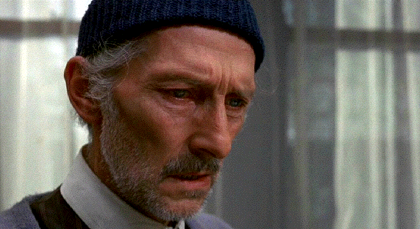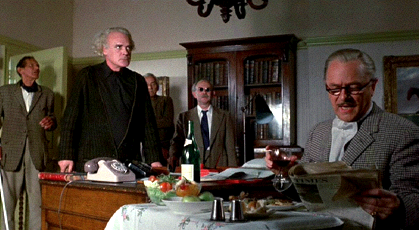Director: Freddie Francis
Writers: Milton Subotsky adapting EC Comics stories by Al Feldstein, Johnny Craig, and Bill Gaines published in Tales from the Crypt and The Vault of Horror
Producers: Milton Subotsky, Max Rosenberg
Cast: Ralph Richardson, Joan Collins, Peter Cushing, Ian Hendry, Richard Greene, Barbara Murray, Robin Phillips, Nigel Patrick, Patrick Magee, Roy Dotrice, Chloe Franks, Martin Boddey, Oliver MacGreevy, Susan Denney, Angela Grant, David Markham, Frank Forsyth, Geoffrey Bayldon, Robert Hutton, Peter Fraser, Manning Wilson, Irene Gawne, Stafford Medhurst, Clifford Earl, Edward Evans, Hedger Wallace, George Herbert, Harry Locke, Jane Sofiano, Peter Thomas, Tony Wall, John Barrard, Robert Rietti (uncredited radio voice)
Five strangers on a tour of a graveyard’s catacombs become separated from the rest of the group and are trapped in a weird stone chamber. They meet a grim, old man (Ralph Richardson) garbed in a hooded robe who shows his apprehensive guests their awful fates.
The Flashback Fanatic movie review
During the 1960s and 1970s, Amicus Productions were the leading contender for British horror movie supremacy against Hammer Film Productions. Amicus seemed to have the most success with their portmanteau format. Amicus produced seven such horror films that each contained multiple stories united by a wraparound narrative.
Of all the Amicus anthology films, Tales from the Crypt is probably the most famous and perhaps the most effective. Each yarn in this film is adapted from a surefire source for this type of material: the infamous, American, 1950s EC Comics series Tales from the Crypt and The Vault of Horror. Each issue of those publications had a similar format of multiple short stories narrated to the reader by ghoulish hosts.
Tales from the Crypt’s fearsome fables are off to a festive start with “And All Through the House.” The drop-dead gorgeous Joan Collins plays Joanne Clayton, a murderous wife caught up in the holiday hustle and bustle of tidying up her Christmas Eve crime scene at the same time a lunatic (Oliver MacGreevy) wearing a Santa Claus costume is trying to break in. There is a perversely cozy, yuletide atmosphere throughout this segment as traditional Christmas carols play on the living room radio while Collins’ cold-blooded beauty takes the time to open the gift from her husband she has just killed before she gets to work staging things to look like an accident. More carols play as she is forced to multi-task between corpse-clean up and locking out the psychotic St. Nick. It is even more perverse in that the murderess is shown to be a loving mother.
The next story has me empathizing a bit with the bad guy. In “Reflection of Death,” Ian Hendry plays family man Carl Maitland who is running away for a new life with his mistress (Angela Grant). There is not a lot of time to flesh out his character, but, in just a few scenes, we see that there is emotional pain and guilt suffered by Hendry’s adulterer abandoning his wife and children. This, more than any other story, makes us realize what a badass fate can be.
Tales from the Crypt does holiday double-duty with “Poetic Justice.” Robin Phillips plays James Elliot, perhaps the most despicable character in the film. He is a young, upper-crust snob obsessing about Arthur Grimsdyke, the kindly, elderly man living across the street. James thinks that the frugal, old rubbish collector and his modest home drive down the property values in the neighborhood. So, James enjoys conducting a secret campaign of harassment meant to drive old Grimsdyke away. Things take a really nasty on Valentine’s Day. Peter Cushing is simply heartbreaking as poor, put-upon Grimsdyke. This is one of my favorite performances by this great actor.
“Wish You Were Here” begins with ruthless businessman Ralph Jason (Richard Greene) and his beautiful wife, Enid (Barbara Murray), facing financial ruin. The Jason couple is contemplating which of their expensive possessions to start selling when they notice the inscription on their old, Chinese statuette. It says that the relic can grant its owner three wishes. Despite Ralph’s reservations, since this situation is eerily similar to that in the classic horror story “The Monkey’s Paw,” Enid makes a wish. That’s when the troubles for the Jason couple really begin.
The final fate that Ralph Richardson’s baleful Crypt Keeper relates is called “Blind Alleys.” It concerns Retired Army Maj. William Rogers (Nigel Patrick) taking over the directorship of a retirement home for blind men. The selfish Rogers spends lavishly on himself from the meager budget allowed the rest home, while the residents have to make due with bad food, poor heating, and not enough blankets. In the role of the blind George Carter, Patrick Magee is the spokesman for his fellow, neglected residents. Magee was a frequent performer in many British genre films. He could be quite unsettling, as he is here. This time, in particular, he has every right to be.
Director Freddie Francis already had plenty of expertise directing fright flicks for Amicus and Hammer. Although Francis did not want to be stuck in the horror rut as a director, he certainly had the knack for this nasty niche. In Tales from the Crypt, he is at his absolute best. Each simple story is just long enough to establish the characters and their situations while never seeming rushed. I suppose that the original comic book stories were almost a storyboard for this film, but Francis knows just how to stage and shoot things effectively. Many creepy sequences play out in purely visual terms with just the right succession of shots effectively building to horrific and ironic climaxes.
Much of the credit for these tight narratives should be given to the original EC Comics stories. The fact that producers Milton Subotsky and Max Rosenberg were Americans probably explains why a British film would be based on the 1950s American horror comics, which were being rediscovered and appreciated in the ’70s.
As has been noted by many others, despite the transgressive acts depicted in horror stories, such narratives often express a very strong morality. That was certainly the case of the once unfairly maligned EC Comics. Those tales were both nasty and satisfying with their ironic justice dealt to evildoers. It is just that kind of cold comfort that makes this film such a satisfying concoction for those who enjoy the morbid mixed with their mirth.
One aspect of this film I appreciate is how it allows its flawed main characters to show little touches of humanity. Each of the five tourists trapped in the crypt become the unethical protagonist of a separate story that The Crypt Keeper tells them. Yet despite the short time allotted to each tale, the film makes us relate to each protagonist as a human being rather than just a hissable villain. Okay, so maybe the vindictive, young snob James Elliot has us hating his guts, but it is hinted that he does have some sense of guilt. Even the selfish and inhumane Maj. Rogers loves his dog. Details like these drive home the moral point that real people can do awful things, so maybe we should examine some of our own choices and motives. All of the regrets and sentiments in people still do not excuse their cruelty.




























